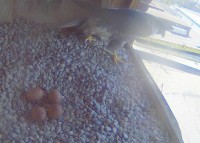Lawrence Peregrines: peeping from egg!
Just after 7AM this morning, the peregrines had overcast skies with fog and mist again, light winds from the east, and temp at 51F. Once again we start the morning off with some areas of fog and even patchy mist. Yet, once again, it will burn off and we’ll return to some sun today as temps rise well into the 60s and 70s. Sound familiar? Certainly the last few days have had similar themes as deja vu greats us walking out the door. While yesterday afternoon was a stunner with highs near 75-80 inland and tons of sun, today, we’ll throw a few more clouds in the mix and even an isolated shower this afternoon, into this evening.
 Finally had a chance to watch the nest at noon time, and kept waiting for one of the incubating peregrines to leave the eggs to see if the first hatch had taken place. Finally, at just after noon time, the female rose up and went to edge of nest box, providing a clear view of all four eggs. Not yet…..stay tuned! So what happens at this point many have asked. Below, from Birds of North America Online, is a preview of the chicks inside the egg and thei making peeping sounds!
Finally had a chance to watch the nest at noon time, and kept waiting for one of the incubating peregrines to leave the eggs to see if the first hatch had taken place. Finally, at just after noon time, the female rose up and went to edge of nest box, providing a clear view of all four eggs. Not yet…..stay tuned! So what happens at this point many have asked. Below, from Birds of North America Online, is a preview of the chicks inside the egg and thei making peeping sounds!
Preliminary Events And Vocalizations
Few data from the wild. From blind near eyries on coastal British Columbia, Nelson could hear chick peeping inside egg before hatching began, becoming louder during hatch; initial pip of shell occurred more than 72 hours before chick broke free completely. In artificially incubated eggs, 24–48 hours before pip, air cell in egg expands and starts extending down one side of egg toward narrow end; normally chick makes pip inside air cell. In 500 artificially incubated eggs, mean time from pip to hatch was 47.8 hours. During this period, chick periodically works to break up area around initial pip but rests most of time. Human imitation of parental chip call stimulates chick to vocalize.
Literature cited:
White, C. M., N. J. Clum, T. J. Cade, and W. G. Hunt (2002). Peregrine Falcon (Falco peregrinus), version 2.0. In The Birds of North America (A. F. Poole and F. B. Gill, Editors). Cornell Lab of Ornithology, Ithaca, NY, USA. https://doi.org/10.2173/bna.660
